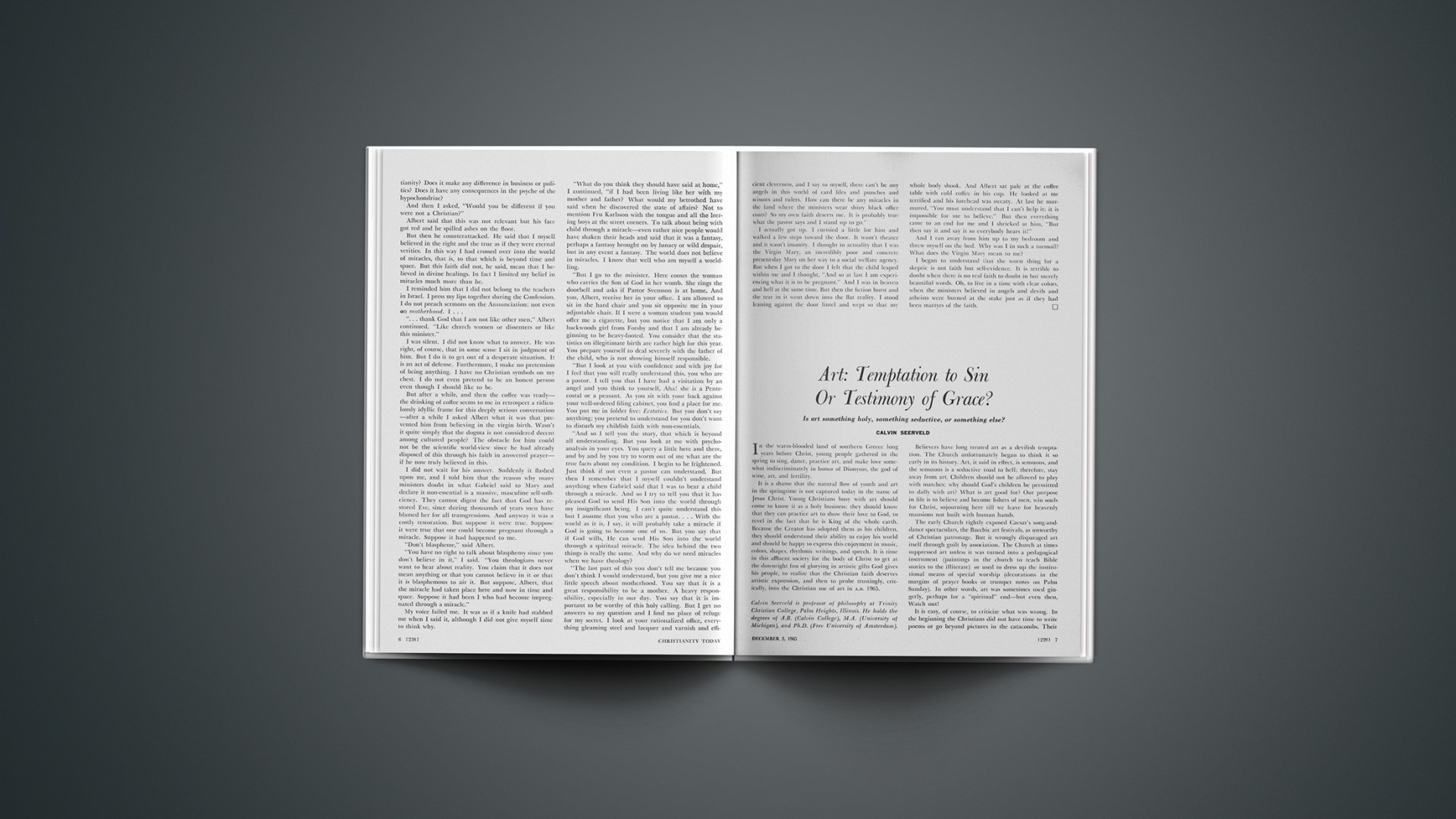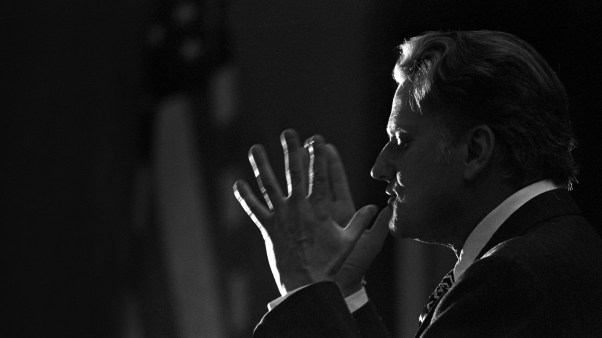Is art something holy, something seductive, or something else?
In the warm-blooded land of southern Greece long years before Christ, young people gathered in the spring to sing, dance, practice art, and make love somewhat indiscriminately in honor of Dionysus, the god of wine, art, and fertility.
It is a shame that the natural flow of youth and art in the springtime is not captured today in the name of Jesus Christ. Young Christians busy with art should come to know it as a holy business; they should know that they can practice art to show their love to God, to revel in the fact that he is King of the whole earth. Because the Creator has adopted them as his children, they should understand their ability to enjoy his world and should be happy to express this enjoyment in music, colors, shapes, rhythmic writings, and speech. It is time in this affluent society for the body of Christ to get at the downright fun of glorying in artistic gifts God gives his people, to realize that the Christian faith deserves artistic expression, and then to probe trustingly, critically, into the Christian use of art in A.D. 1965.
Believers have long treated art as a devilish temptation. The Church unfortunately began to think it so early in its history. Art, it said in effect, is sensuous, and the sensuous is a seductive road to hell; therefore, stay away from art. Children should not be allowed to play with matches; why should God’s children be permitted to dally with art? What is art good for? Our purpose in life is to believe and become fishers of men, win souls for Christ, sojourning here till we leave for heavenly mansions not built with human hands.
The early Church rightly exposed Caesar’s song-and-dance spectaculars, the Bacchic art festivals, as unworthy of Christian patronage. But it wrongly disparaged art itself through guilt by association. The Church at times suppressed art unless it was turned into a pedagogical instrument (paintings in the church to teach Bible stories to the illiterate) or used to dress up the institutional means of special worship (decorations in the margins of prayer books or trumpet notes on Palm Sunday). In other words, art was sometimes used gingerly, perhaps for a “spiritual” end—but even then, Watch out!
It is easy, of course, to criticize what was wrong. In the beginning the Christians did not have time to write poems or go beyond pictures in the catacombs. Their minds were taken up with formulating confessions against heresy and codifying doctrines to stop civil misunderstandings. However, it is a different matter when Christians piously argue whether art is worth less than other human activities, generally implying with classic pedantry the old error that art is a romantic spasm unfit for Christians, unless it somehow be bent to church worship.
But if the Christian community maintains a prohibitionist or, at best, a permissive conception of art, it has missed a critical area of Christian action and affronted God. If the Church does not like the jazz, painting, and literature of today, what does it expect if it does not encourage its baptized children to produce something Christianly different?
Whenever God-created drives or talents in men are denied meaningful exercise, there is trouble. Man’s glories then become a temptation to sin. Temptation is much more complicated and casual an affair than a scantily clad woman accosting a hungry St. Anthony in a wilderness of stumps, logs, water, and grass. Temptation is always the opportunity for one to satisfy his God-given needs and desires in ways that ignore God’s loving ordinances for the exercise of human abilities.
When God’s adopted children who are especially talented in being sensitive to the wonder of the world and culturally and artistically responsive to it are frustrated by Christian kill-joys (cf. 1 Timothy 4:1–4), then the devil, who covets culture and its human makers, knows how to twist art into temptation to sin. He subtly gets believers with artistic talent so wrapped up in the truly God-created enjoyment of art, especially in reaction to unbiblical prohibitions, that they forget that art itself must be practiced before the face of the holy God and Lord. Disregarding that, the artist becomes tempted to think and act as if his artistic deed had its own right to be and was naturally revelational of God’s Truth rather than being a humanly conditioned response to God’s glory. Unless art is conceived and practiced (albeit subconsciously) as a channel for the Holy Spirit’s witness to others of one’s being a perceptive son of God, it should be forgotten. Otherwise one has made art its own lord and has swallowed the devil’s bait. Unless art is itself a praise response, a hallelujah to God in the world—not churchy moralism, not a forced, derived, lugged-in Christianized witness, but a joyous, ministering hallelujah praise, it will be stillborn—no matter how elegant the music, painting, prose, and poetry may be.
A peculiar thing about art that offends so many serious-minded Christians is its playful, leisurely, imaginative character. If we want art to walk in through the front door of the Christian community rather than to be quietly smuggled in the back door, it must be made plain to the uninitiated that writing, painting, singing, and playing are hard work of a highly talented sort—that their make-believe is not faking, pleasant nonsense, but an excruciatingly careful, symbolical formulation of what the artist knows or supposes the world to be about.
In a famous exchange, Matisse was told by a woman in an art gallery who was looking at one of his curving, twisted black swirls, “I never saw a woman like that.”
THE LIGHT SHINETH IN DARKNESS
From a dark dust of stars
Kindled one, a prick of light.
Burn, small candle star,
Burn in the black night.
In the still, hushed heart
(Dark as a black night)
Shine, Saviour newly-born,
Shine till the heart’s light.
LUCI SHAW
“Madame,” said Matisse, “that is not a woman; it is a painting!”
And his painting was not unreal because it was not a woman, nor was it false and unimportant because it was “exaggerated”; for Matisse discloses and affirms in color the voluptuous viciousness of a wanton that could perhaps be shown no other way.
If adult painters were merely working out some of their subconscious shrieks in colors and if musicians were performing simply because their mothers made them practice the piano early in life, then art would indeed not deserve to be taken seriously by the public. But since art is a man or woman’s modest but intense contribution to his neighbor’s grasp of corners of reality, states of affairs, levels of meaning not often explored but present in creation all the time—caught by him as artist in symbols for the other’s appropriation—what the Christian artist does is significant for building up the body of Christ and speaking to those who will listen.
If we could convey to the skeptical in the Church that the artist stands like a child toward the world—not, to be sure, innocent, not void of moral obligation, but childlike, fresh, open, giving himself to discover, penetrate, and grasp what is out there in creation as well as inside his self-consciousness, wondering for Christ’s sake; if we could make church people see that the artist needs leisure, the kind of leisure college students have near the end of a semester when they work day and night round the clock thrown out the window, not meeting carefully apportioned deadlines but concentratedly busy at a pitch of excitement—if we could convey something of this, then perhaps we could break through to the Christian mentality that understands missions, preaching and teaching, hard work as service to God, but has trouble relaxing in laughter before his throne. There is a lot of laughter, love, Sunday to art rightly understood, features for which Christians are uniquely constituted. Christians can give themselves to the task because their involvement is not artificially manufactured for selfish or pragmatic reasons but is simply a matter of spontaneous thanksgiving because God in his world is so great and merciful.
By Sunday I do not mean a legal holy day bored through with interminable talk, stuffy formalism, and lap lunches, but rather the day of rest God gives us, the God-created leisure, the vacationing celebration men may have and need no less than a six-day week. Sunday is to be a joyful anticipation of the coming resurrection in which believers will blossom, each according to his own talented nature (1 Cor. 15), bringing the glory and honor of the world’s kingdoms fully to Jesus Christ (Rev. 21:24, 26). Art has this innate festive character—not that it is specially holy (that is the companion error to judging it inherently suspect) but that it is a specially tempting occasion for a man in the sense of Psalm 1 to bring forth fruit leisurely ripened to please God.
Because artistic talent is God’s gift to his creatures, we should take seriously the scriptural imperative to develop that talent if we have been blessed with it—to discipline and hone its craft-element, so that when the Lord comes back to see how we have passed the time of day with what he has given us, when he comes to judge our artistic efforts, we can be quietly glad that the five, two, or one talent is doubled. That is the biblical, apocalyptic background to studying, performing, and criticizing one another’s art in a communion of saints.
What is the Church and the believing artist to do with all the modern art that mistakes the world, perverts creation in despair, or, giggling nervously, is empty of praise?
Responsible Christians must make a point of examining such art critically in order to be exactly aware of the culture they are caught in, so that they can be stirred to develop the art of praise.
Believers frequently cut a sorry figure in the contemporary world, because they practice an unbiblical otherworldliness. Recently our college organized a tour for a large group of young Christian artists at the Art Institute of Chicago. We told the director we wanted a tour concerned with the intrinsic relation of art and faith, that we wanted the guides to show us the biblical truth that a man’s final commitment to whatever he holds dear and inviolate necessarily, though subtly, appears in his work.
And the director said, “You mean medieval art, crucifixes, and church symbols?”
“No.”
“Perhaps our Buddhist, Hindu, Oriental religious art treasures?”
“No. Rather, what does, for example, contemporary art say about the world? What does the artist mean with his canvas? Could you explain to us who come from Trinity Christian College what spiritual expression modern art conveys?”
“Oh, yes, but you wouldn’t like it,” he said. “It is not very pleasant, sometimes.”
“But that is what we want!”
In the tour coming out of this conversation (“Contemporary Spiritual Expressions in Art”), we saw some highly articulate vomiting, symbolically expressive anarchy, whimsicality, cursing in art, as well as random playful comments on human foibles and the unutterably pathetic blue canvas of Picasso’s man with a guitar. It became clear to those with eyes to see that contemporary artists have largely turned the world topsy-turvy, that they ask God questions and berate him for not answering, while all the time God is asking, “Do you love me?” and men are not answering. Such perversion does not stop us Christians from learning bits and snatches from these terribly perceptive, acutely gifted, unbelieving artists, because they are bound (if they would communicate) by the laws of God for art in this world—laws they would like to violate! But their godless art, the blank, distorted, dead-end picture of the world they present, is a lie! That is not the way the world is; that is the way the world looks when seen without the Gospel today, without the Good News of Jesus Christ.
The evangelical, Reformational Christian upshot to such a confrontation is not to demand that all become eunuchs for the Kingdom of God (Matt. 19:12) but rather to plead that believers, having seen such art, should go home and exercise their artistic birthright, pained that God does not hear hallelujahs from this planet above the cries of secular disbelief.
While society becomes increasingly secularized, war-torn, and giddy, the artists in Christ’s body should be encouraged by us all to embody—whether in poetry, painting, music, or speech—hope in their sorrows, to show love through their disappointments, to communicate to whoever listens, in an idiom intelligible in A.D. 1965 (and that may mean no major chords, no prim representations, no heroic couplets), that the struggle in the world by those who believe is done joyously for a sure prize, the glory of God we now already share in Jesus Christ.
The direction Christ’s body must take is clearly shown in the Scriptures. As the manifesto of Psalm 150 says:
Hallelujah! Jehovah!
Hallelujah God in his holy place!
Hallelujah him through the heavens which he rules!
Hallelujah God for his sovereignty!
Hallelujah him in the overwhelmingness of his grandeur!
Hallelujah him with the blast of trumpets!
Hallelujah him with harps and bass violins!
Hallelujah him with (bouncing) tambourines and dance!
Hallelujah him with stringed instruments, with flutes,
Hallelujah him with ringing castanets!
Hallelujah him with cymbals crashing joyfully!
Let every thing that has a breath hallelujah Jehovah!
Hallelujah Jehovah!
If a Christ-follower holds Jehovah God as his Lord, then for the sake of his Lord let him sing, play, paint, and write him a hallelujah in the presence of the faithful and of his enemies. Such is the joyful ministry of the Christian artistry we need to be engaged in.










